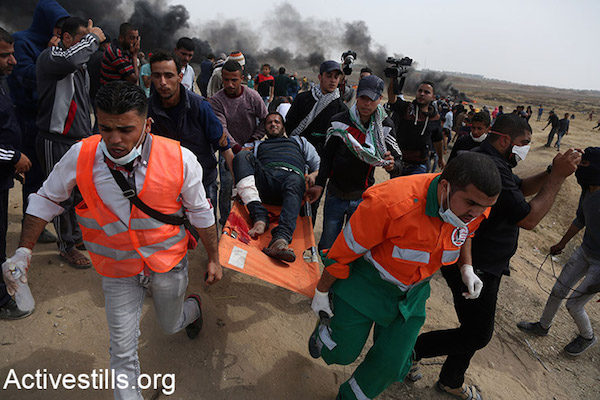If Hamas allows Israel to drag it into another lopsided fight, it will not only cost the lives of countless innocent civilians in Gaza, it will also distract from ongoing mass resistance to the siege.

Israel’s killing of Hamas commander Nour Baraka on Sunday and the predictable response from the Islamist movement have sparked fears of renewed hostilities between the two sides. Although it remains unclear whether Baraka’s killing was planned or the result of a botched Israeli “intelligence-gathering” operation, many observers see parallels with Israel’s 2012 assassination of Ahmad Al Jabari, then the head of Hamas’ military wing. That incident set off eight days of fighting in which six Israelis and 167 Palestinians were killed.
If the deadly exchange six years ago was about avenging a senior Hamas commander, its casualties, even according to the Israeli military’s official figures, were mostly civilian. The same outcome would surely follow another confrontation, as any sustained Israeli air assault would no doubt send Hamas operatives into hiding. Both sides know this, and though Netanyahu has demonstrated time and again that he will not hesitate to kill innocents, especially in pursuit of domestic political gain, what options does Hamas have?
To explore this question, we must be clear about what is at stake.
Whether they intended it or not, Israel’s military planners know that Baraka’s killing will bait Hamas. Any sustained response by the Palestinian faction would clearly benefit Netanyahu, who has been lambasted by his political opponents for allowing $15 million in Qatari cash to be transferred to the Strip, mostly as a stop-gap against its ongoing descent into chaos.
Yet despite the fallout from that move, Netanyahu has a more pressing political problem — mass resistance to Israel’s ongoing siege and the humanitarian disaster it has created.
According to recent estimates, some 200 Palestinian protesters, part of the thousands who march each week along Israel’s self-declared “border” with Gaza, have been gunned down by state snipers while a further 18,000 have been injured, many by live fire. These victims include the wheelchair-bound 29-year-old Ibrahim Abu Thuraya, whom Israeli snipers shot in the head with live ammunition, an act the UN High Commissioner for Human Rights called “truly shocking and wanton”; and 21-year-old volunteer medic Razan Al-Najar, who wore a white uniform and, according to eyewitness reports, had her hands raised when an Israeli sniper shot her through the chest, ending her life.

These horrific killings, combined with the almost incomprehensible courage that continues to drive unarmed protesters to the border, have elicited both outrage and solidarity from unlikely places. Major artists like Natalie Portman and Lana Del Ray have pulled out of events in Israel, adding to the momentum of the Palestinian BDS movement. And the recent midterm elections in the United States made clear that American voters are willing to back candidates critical of Israel.
This extraordinary shift in attitudes is the real threat to Netanyahu and the status quo he seeks to preserve in Gaza, including through last week’s cash infusion to Hamas. The question is whether Hamas will allow the Israeli leader to drag it into another lopsided fight, which will not only cost the lives of countless innocent civilians, but also distract from ongoing mass resistance to the 12-year Israeli siege.
Any Hamas response must begin with a clear-eyed appraisal of the tactics best-suited to the Palestinian struggle. But such a calculation will require the movement’s leaders to see beyond their urge to retaliate for Baraka’s killing. After all, if Hamas is truly representative of the people it claims to defend, the death of one of its commanders can be no more of a tragedy than the deaths of Abu Thuraya, Al-Najar, and the hundreds of other Palestinians killed during the Great March of Return — to say nothing of the thousands more who lost their lives during the preceding three wars on Gaza.
As Hamas calculates its next moves, I am reminded of another historical moment, retold in the outstanding documentary, Naila and the Uprising. The film follows a group of Palestinian women who, together, were at the frontlines of the first intifada, which captured the world’s attention by exposing the brutality of Israel’s response to unarmed protests. These women single-handedly commanded everything from farming collectives to elaborate communications networks designed to keep the resistance one step ahead of the Israeli military. And they did all of this without direction from Yasser Arafat and the PLO, which sat on the sidelines of the intifada from its headquarters in Tunis.
Arafat would eventually steal back the spotlight, though. Although Naila anchors the eponymous film’s narrative — with harrowing accounts of her arrest, torture, and exile at the hands of occupation authorities — what she and her comrades ultimately have in common is their betrayal by the Palestinian “leadership,” which agreed to the terms of the disastrous Oslo agreement without so much as consulting any of them. That these men, newly returned as part of a Palestinian “authority,” then marginalized the very women responsible for their posts only underscores the point.
As we hold our breaths during this latest “escalation” — between an Israeli government recently put on notice by the International Criminal Court and a Palestinian faction that routinely uses torture to silence dissent — let us remember that, though they may beat their chests and claim their mantles, there are no heroes among them. The truth is that Baraka’s killing has not changed the stakes for Gaza’s two million Palestinians, who, like their compatriots in the West Bank and Israel, will continue to find ways to resist the daily injustices of occupation. Ultimately, neither Netanyahu nor Hamas can eclipse them.

